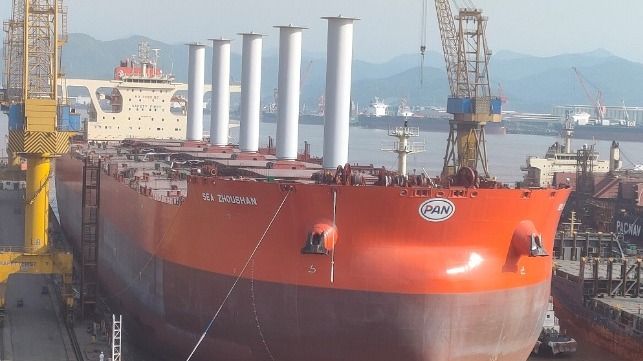Vale Tests Flettner Rotor Wind Power on Giant Ore Carrier

Leading Flettner rotor manufacturer Norsepower has installed five tilting rotor sails on the deck of a brand new very large ore carrier (VLOC), the Sea Zhoushan, which will be owned by Pan Ocean Ship Management and chartered to Brazilian mining giant Vale. It marks the first installation of Norsepower’s rotor sails on a bulker, one of the largest Flettner rotor installations ever implemented, and one of the first wind-assisted propulsion systems of any kind aboard a vessel of this gigantic size class.
The five-rotor project could reduce the 325,000 dwt ship's fuel costs and emissions by about eight percent, according to Norsepower - cutting the ship's annual CO2 emissions by about 3,400 tons. In order to allow cargo operations to proceed smoothly when in port, the rotor sails can be tilted over and out of the way using hydraulic cylinders.
The Norsepower system is fully automated, and it detects whenever the wind is strong enough to deliver fuel and emission savings. At that point, the rotor sails start automatically.
"We are delighted to be working with Vale, and supporting them to maximize the propulsive power of wind to reduce carbon and other emissions as well as protecting the sustainability of its value chain more broadly," said Tuomas Riski, CEO of Norsepower. “The five tilting rotor sails will allow Vale to maintain flexible cargo operations while also saving fuel and emissions. Installing our rotor sails on [our] first VLOC demonstrates that our technology is adaptable across varied operational profiles and vessel types."
According to Norsepower, wind-assisted propulsion is also a viable compliance option for meeting upcoming EEXI and CII rating requirements. All of these advantages are attractive to Vale, which could potentially install rotor sails on a substantial fraction of its fleet.
"We are committed to supporting the adoption of clean technology solutions for shipping to ensure that Vale’s sustainability objectives are achieved. Installing five rotor sails will maximize our fuel and emissions savings," said Rodrigo Bermelho, shipping technical manager for Vale. "If the pilot proves effective, it is estimated that at least 40 percent of the fleet will be able to use the technology, which would result in a reduction of almost 1.5 percent of Vale's annual iron ore maritime transport emissions."
